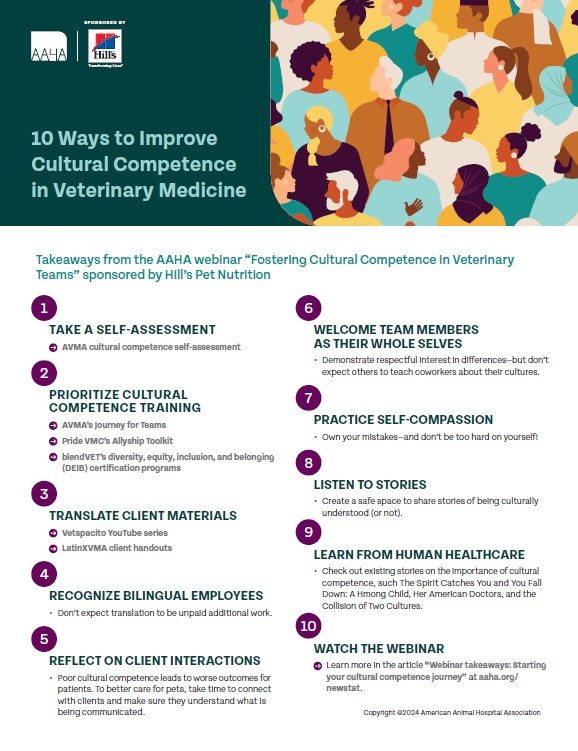Webinar takeaways: Starting your cultural competence journey

Webinar details
Fostering Cultural Competence in Veterinary Practice
Moderator: AAHA Chief Medical Officer Jessica Vogelsang, DVM, CVJ
Panelists:
- Omar Farías, VMD
- Marina Tejada, DVM
- Tyler Primavera, DVM
- Sara Taylor, CVT
Printable Handout for
|
How to watch
This webinar is hosted in AAHA Learning, AAHA’s digital learning platform. Sign up to create a FREE account and register. Check out this video tutorial for a walk-thru. Once logged in to AAHA Learning, you can access a direct link to the Fostering Cultural Competence in Veterinary Practice webinar.
ICYMI: Key webinar takeaways
When asked to define cultural competency in the recent AAHA webinar sponsored by Hill’s Pet Nutrition, Fostering Cultural Competence in Veterinary Practice, all the panelists agreed it starts with the individual.
To better understand others, we must first examine how our own experiences and biases affect interactions with our coworkers, clients, and communities. When we approach this task with humility and curiosity, we set the tone for more trusting and respectful relationships.
The panelists laid out some of the many cultural attributes to keep in mind when examining how we can work better with our broad range of clients and teammates. These include (but are not limited to) language, ethnicity, religion, gender identity, sexual orientation, and diversity of experience.
The importance of cultural competence in vet med
Primavera, co-founder of Vetspacito, shared a poignant example of how language barriers can affect the care our patients receive.
He recalled a case where a puppy came into his clinic with a severe flea infestation. The adult owners of the dog only spoke Spanish and Primavera only spoke English. The owners’ young daughter attempted to translate Primavera’s recommendations into Spanish for her parents, but the family ended up declining all treatment and never returned to the practice.
This experience inspired Primavera to start learning Spanish and to co-found Vetspacito with the goal of helping veterinary professionals communicate more easily with their Spanish-speaking clients.
Now, veterinary professionals who find themselves in a situation similar to Primavera’s can pull up one of Vetspacito’s free Spanish YouTube videos that explain common veterinary topics so that pet owners will better understand things like bloodwork, anesthesia, and vaccinations.
People may not ask for the help they need
Tejada added that clients in need of services like translation may not always ask for it. This may be due to a sense of shame or not knowing that such services exist. Farías shared this sentiment, adding that he often had clients travel hours to see him once they knew he could speak with them in their native language.
As a member of the gay community, Farías has also had gay couples who preferred to see him as their veterinarian because they felt more comfortable not having to hide their relationship as they sought care for their pets.
Cultural competence in hiring
As a hiring manager, Taylor discussed how cultural competency and humility have affected her hiring experiences. While we live in a multicultural society, she pointed out, veterinary professionals are still overwhelmingly white as a profession.
Years ago, she found herself inadvertently hiring individuals who all fit the same mold. Not wanting to be “part of the problem,” she took a hard look at her own hiring practices. She stresses the importance of the veterinary team having a cultural makeup that represents the community they serve.
Ways to improve cultural competence in veterinary teams
The panelists offered several helpful tips for teams who want to improve the ways in which they connect and foster trust with their colleagues and clients:
Take time to connect
Taylor advised, even when the day is busy, it’s important to take time with clients to meet them where they are, ask questions, and find out what they need. Resist the urge to judge a client as noncompliant when they decline recommendations. Instead try to look for an underlying reason, which may lead to a breakthrough in communication.
Identify resources
Use appropriate resources for the community the practice serves. Tejada recommends having documents and handouts translated into other languages, such as those provided by LatinX VMA.
Even without language barriers, clients often can’t fully digest what they’re being told in the moment—especially if it’s a scary diagnosis. Translated take-home materials (or links to videos such as those from Vetspacito) give the client a chance to absorb the details once they’ve left the practice.
Invest in your team
Employers and managers should recognize the value of bilingual employees and compensate them accordingly, Taylor said. It’s not fair for the one Spanish-speaking vet tech or CSR to be the default translator without any additional compensation.
In order to diversify veterinary teams—especially when hiring assistants and CSRs—Taylor emphasized the importance of being willing to train some employees “from the ground up.” Look for people with great personalities and willingness to learn when hiring these entry-level jobs rather than requiring candidates to already have veterinary practice experience.
Prioritize cultural competence training
Just as we have mandatory trainings on topics like cybersecurity and harassment, Tejada feels cultural competence training should be required for all teams.
There are veterinary-specific resources to choose from, including:
- AVMA’s Journey for Teams
- Pride VMC’s Allyship Toolkit
- blendVET’s diversity, equity, inclusion, and belonging (DEIB) certification programs
Welcome team members as their whole selves
This can include demonstrating respectful interest in cultural attributes that are different from your own. Be aware, however, that not every team member will want to take on the responsibility of teaching their coworkers about their unique cultural attributes or be defined by them.
Take a self-assessment
Tejada advocated for leaders to take the first step by doing a cultural competence assessment such as the one offered by the AVMA. Then, she said, encourage your team members to take it as well—although don’t force them to share their results, only to use it as an awareness exercise.
“This can be humbling,” Tejada warned, “as you may not recognize where you have biases.”
Practice self-compassion
Veterinary professionals tend to be perfectionists, Farías said, which can lead to guilt and shame. “Own your mistakes and move on. Don’t be too hard on yourself.”
And it’s just as important to celebrate small wins. Developing cultural competence is a journey that will take time.
“If you have good intentions and lead with good intentions,” he said, “that is a good place to start.”
Emily Singler, VMD, is AAHA’s Veterinary Content Specialist.
Disclaimer: The views expressed, and topics discussed, in any NEWStat column or article are intended to inform, educate, or entertain, and do not represent an official position by the American Animal Hospital Association (AAHA) or its Board of Directors.
NEWStat Interesting/unusual Client communication Events & CE Practice management




